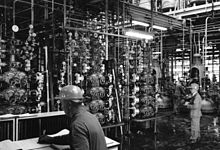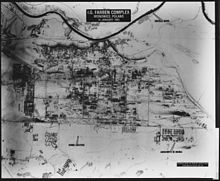Buna (rubber)
Buna is now a synonym for synthetic rubber .
history

The styrene-butadiene rubber was developed in 1926 by the German chemists Walter Bock and Eduard Tschunkur at the IG-Farbenindustrie in the Leverkusen plant and a patent was applied for on January 15, 1927. The name “BuNa” is derived from the synthesis components butadiene and sodium . Sodium acted as a catalyst for the polymerization of butadiene in the presence of styrene. Buna (-S) is a copolymer of 70% butadiene and 30% styrene , natural rubber is an isoprene - polymer . The word mark was protected on July 11, 1929 for the IG colors industry.
In autumn 1935 the IG Farbenindustrie established a first production facility under the name " Buna-Werke " Schkopau (later also Chemische Werke Buna Schkopau) in the area of the communities of Schkopau and Korbetha north of Merseburg in what is now Saxony-Anhalt . The lignite mined in the Geiseltal served as an energy source ; the neighboring Leuna works on the outskirts of the city of Leuna supplied the necessary hydrogen . Mass production began in 1939. The process was also licensed to Chemische Werke Hüls , a 74 percent subsidiary of IG Farben, which was founded in Marl in 1938 for the purpose of Buna production . The mining company Hibernia , which owned the remaining 26 percent of the shares, supplied the necessary raw materials. Here too, mass production was in operation three years later.
Since the National Socialist regime strived for independence from imported raw materials (here natural rubber ), Buna was produced on an industrial scale for the first time in 1937. A third IG colors company was designed for Fürstenberg at the end of the 1930s , but was ultimately implemented in 1940 at the Ludwigshafen am Rhein plant .
From 1941 on, IG Farben built a fourth Buna plant measuring around 20 hectares at the Auschwitz III Monowitz concentration camp . 40% of the plant was used for fuel production, 60% for rubber production. Forced laborers were used to build the IG Auschwitz plant , 20,000 to 25,000 of whom died in this system of extermination. The average life expectancy of a forced laborer building this plant was three months and the labor camp numbered up to a hundred thousand prisoners. This plant was the largest construction site in Europe in 1944. In the second half of 1944 it was bombed four times by the US Air Force.
The synthetic production of rubber became important for the USA after Japan cut off the USA from Malaysia, its main rubber supplier, in the Second World War . The rights of use for the German Buna patent were initially held exclusively by Standard Oil of New Jersey . Due to an agreement with IG Farben, Standard Oil refused to release the Buna patent for other American manufacturers. A commission of inquiry accused Standard Oil of New Jersey of "continuing conspiracy in favor of Germany", and Harry S. Truman even spoke of "treason" at a press conference. The American Congress thereupon ordered the annulment of the German exclusivity regulation in favor of Standard Oil of New Jersey.
This exclusivity regulation came about because in return the Third Reich was allowed to purchase the anti- knock fuel additive lead tetraethyl from Standard Oil of New Jersey and Standard Oil of New Jersey was also involved in the German-American Petroleum Company.
Significance for the German war economy
| year | advent total |
of which synthetic production |
percent |
| 1939 | 99,000 | 22,000 | 22nd |
| 1940 | 57,000 | 40,000 | 70 |
| 1941 | 96,000 | 69,000 | 72 |
| 1942 | 123,000 | 98,000 | 80 |
| 1943 | 124,000 | 117,000 | 94 |
| 1944 | 104,000 | 104,000 | 100 |
During the armament of the Wehrmacht , the supply of rubber and fuel production represented a major bottleneck. In contrast to oil, the German Reich was completely dependent on overseas imports for rubber supplies, so that enormous funds were invested in synthetic rubber production at an early stage. Preparations for a colonial economy that would have enabled access to natural rubber extraction were discontinued in view of the war situation. According to the Krauch Plan, the pre-war consumption of rubber was to be covered by self-production in 1943, which was achieved with the three Buna factories. A motorization of the Wehrmacht, which is essential for modern warfare, could not be achieved. This increased wartime economic demand was not to be covered until 1944 by the fourth Buna plant near Auschwitz, which, however, never started production.
The production of synthetic rubber was technically problematic. A small amount of natural rubber was still required for the production of tires , which had to be brought in from the ally Japan with great difficulty by blockade breakers . Furthermore, the production was extremely energy-intensive. 40,000 kilowatt hours of electricity were used to produce one tonne of Buna, while synthetic gasoline consumed only 3,000 kWh. A retrospective examination shows that with the equivalent of the immense financial investments, natural rubber stocks could have been created in an order of magnitude that corresponded to the amount of Buna self-production during the war years. However, this calculation was opposed to the interests of the IG Farben concern and the autarky plans of the Nazi leadership.
Today's Buna production
After the Second World War , production was banned by the British occupation authorities, but reopened in 1950 as a result of the Korean War .
In the meantime, there are different types of Buna that are offered by Lanxess AG for the manufacture of various industrial products such as cable sheathing , seals , hoses , conveyor belts and tires .
Trinseo Deutschland GmbH (formerly Styron, spun off from Dow Chemical ) also produces synthetic rubber (cold polymerizate) in Schkopau and markets this, among other things. a. under the brand name Buna SB.
Under the trade names Perbunan N (formerly Buna N) or Europrene N, seals, hoses and rubber gloves made of acrylonitrile-butadiene rubber marketed.
Others
To this day, the term “Buna” is used in connection with the Marl Chemical Park , formerly “Chemische Werke Hüls” (CWH), although synthetic rubber is no longer manufactured there.
The Buna factory in Schkopau operated under the name VEB Chemische Werke Buna Schkopau during the GDR era . “Plastic and Elastic from Schkopau” was written on the Elbe bridge of the A9 transit motorway and advertised the products of this company.
Web links
Individual evidence
- ↑ Patent DE 511145 (method for the preparation of artificial rubber) , filed January 15, 1927, granted October 16, 1930.
- ↑ Trademark register DD419435 and DE507563 , word mark “Buna” registered for IG-Farbenindustrie, after the liquidation of IG 1951/52 the rights were transferred to the successor companies. Today the brand is owned by Dow Chemical and Lanxess .
- ↑ Extracts from the US Strategic Bombing Survey, summarizing 15th Air Force bombing attacks on Oswiecim (Auschwitz)
- ↑ Bernd C. Wagner: IG Auschwitz. Forced labor and extermination of prisoners from the Monowitz camp 1941–1945. Munich 2000, ISBN 3-598-24032-5 , p. 187.
- ↑ Military History Research Office : The German Reich and the Second World War . Volume 5/2, p. 434.
- ↑ Dietrich Eichholz: History of the German war economy. Volume 2, Akademie-Verlag, Berlin 1985, p. 356.
- ↑ The German Reich and the Second World War . Military History Research Office , Volume 5/2, p. 456.
- ↑ The German Reich and the Second World War . Military History Research Office , Volume 5/2, p. 443.
